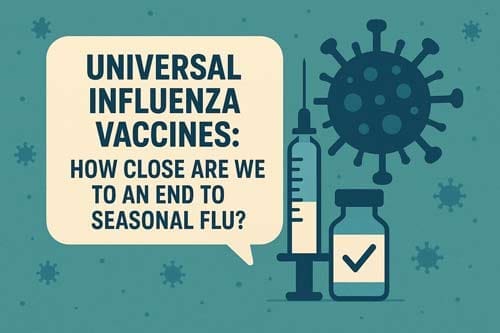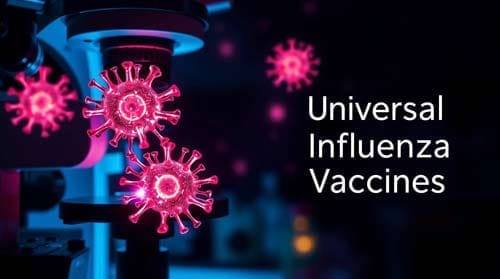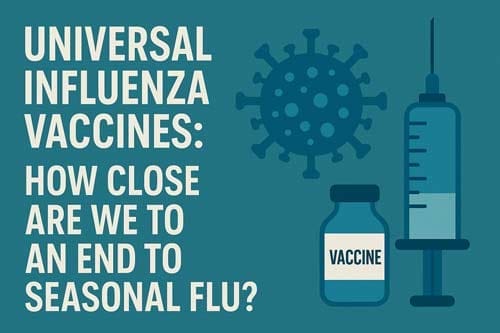Universal Influenza Vaccines: How Close Are We to an End to Seasonal Flu?
Please like and subscribe if you enjoyed this video 🙂
Abstract
This paper explores the current progress in developing universal influenza vaccines and their potential to eliminate seasonal flu epidemics. It reviews recent technological advances, ongoing clinical trials, and the challenges of creating vaccines that offer broad protection. The analysis uses data from different research efforts and assesses the impact on public health. While significant progress has been achieved, several key obstacles must still be overcome before a universal flu vaccine becomes widely available.
Abstract
This paper explores the current progress in developing universal influenza vaccines and their potential to eliminate seasonal flu epidemics. It reviews recent technological advances, ongoing clinical trials, and the challenges of creating vaccines that offer broad protection. The analysis uses data from different research efforts and assesses the impact on public health. While significant progress has been achieved, several key obstacles must still be overcome before a universal flu vaccine becomes widely available.
Introduction
Influenza, commonly called the flu, continues to pose a significant global health threat. Seasonal outbreaks result in widespread illness, hospitalizations, and deaths each year. Current vaccination strategies rely on annual formulations based on predictions of circulating strains. This approach has limitations, including mismatches between vaccine and virus strains and yearly immunization needs. A universal influenza vaccine could change how we prevent the flu. It would provide lasting protection against many strains and even stop seasonal outbreaks.

Current State of Seasonal Flu Vaccines
Limitations of Current Vaccines
Influenza, commonly called the flu, continues to pose a significant global health threat. Seasonal outbreaks result in widespread illness, hospitalizations, and deaths each year. Current vaccination strategies rely on annual formulations based on predictions of circulating strains. This method has some limits. For example, there can be mismatches between the vaccine and the virus strains. Also, yearly immunization is needed. Developing a universal influenza vaccine that offers long-lasting, broad protection against multiple strains could revolutionize flu prevention and potentially eliminate seasonal epidemics.
Impact on Public Health
Despite these limitations, seasonal influenza vaccines are crucial in reducing the incidence of flu-related illnesses and complications. They help decrease the strain on healthcare systems and offer essential protection to high-risk populations. The differences in effectiveness show a clear need for better and more lasting vaccination solutions.
Universal Influenza Vaccine Development
Concept and Goals
The primary objective of a universal influenza vaccine is to provide comprehensive protection against a wide array of influenza virus strains, including those with the potential to trigger future pandemics. This approach’s key goals are to create longer immunity that works well against different influenza subtypes. Ideally, such a vaccine would eliminate the need for annual immunizations and offer protection against seasonal and emerging pandemic strains.
Approaches to Universal Vaccine Design
Researchers are exploring several innovative strategies to develop universal flu vaccines:
One way to tackle this is by targeting conserved viral proteins. These are parts of the influenza virus that stay stable across various strains. By directing the immune response to these consistent regions, vaccines may offer broader protection.
Another strategy involves stimulating the production of broadly neutralizing antibodies. These antibodies can spot and neutralize different influenza subtypes, boosting the vaccine’s protective range.
T–cell–based approaches are also under investigation. These aim to boost cellular immunity, which is crucial in fighting infections, especially when antibody responses are insufficient.
In addition, novel adjuvants—substances that enhance the body’s immune response to a vaccine—are being tested to improve the strength and duration of immunity.

Recent Advancements in Universal Flu Vaccine Research
Several promising universal flu vaccine candidates have shown encouraging results in preclinical and early clinical trials. One such candidate, FLU-v, is a peptide-based vaccine designed to target conserved regions of influenza proteins. Early trials have indicated its potential to induce broad immune responses. Another candidate, M-001, is a recombinant vaccine with conserved epitopes from influenza A and B viruses. It has progressed to later stages of clinical testing.
Additionally, H1ssF_3928, a nanoparticle-based vaccine, has been engineered to elicit broadly neutralizing antibodies. Early studies show it might provide strong cross-strain protection, making it a key player in universal vaccine development.
Universal flu vaccine candidates are currently advancing through various phases of clinical evaluation. Several vaccines have demonstrated safety and the ability to generate immune responses in Phase 1 trials involving human volunteers. Some candidates are now in Phase 2 trials. Here, they are tested on how well they work and how long their immune response lasts in larger groups. Only a few have moved to Phase 3 trials. These trials test their effectiveness in real-world, large-scale settings. These trials are critical for determining the vaccines’ ability to prevent influenza illness across diverse demographics and viral strains.
Challenges in Universal Flu Vaccine Development
Scientific Hurdles
Developing a universal influenza vaccine presents significant scientific challenges. One of the foremost difficulties is the extensive genetic diversity of influenza viruses. Their constant evolution and variability make it difficult to create a single vaccine that offers broad and lasting protection. Influenza viruses have evolved mechanisms to evade the immune system, further complicating vaccine design.
Another critical challenge is achieving cross-reactivity. Targeting conserved viral regions can widen protection, but it’s crucial to ensure safety and effectiveness aren’t compromised. Balancing immune response breadth with vaccine potency remains a complex scientific task.
Regulatory and Logistical Challenges
Developing a universal influenza vaccine presents significant scientific challenges. One of the foremost difficulties is the extensive genetic diversity of influenza viruses. Their constant evolution and variability make it difficult to create a single vaccine that offers broad and lasting protection. Influenza viruses have evolved mechanisms to evade the immune system, further complicating vaccine design.
Another critical challenge is achieving cross-reactivity. Targeting conserved viral regions can widen protection, but it’s crucial to ensure safety and effectiveness aren’t compromised. Balancing immune response breadth with vaccine potency remains a complex scientific task.
Potential Impact on Public Health
Benefits of a Universal Flu Vaccine
Developing a universal influenza vaccine presents significant scientific challenges. One of the foremost difficulties is the extensive genetic diversity of influenza viruses. Their constant evolution and variability make it difficult to create a single vaccine that offers broad and lasting protection. Influenza viruses have evolved mechanisms to evade the immune system, further complicating vaccine design.
Another critical challenge is achieving cross-reactivity. While targeting conserved viral regions can help broaden protection, it is essential to do so without compromising safety or effectiveness. Balancing immune response breadth with vaccine potency remains a complex scientific task.
Implications for Healthcare Systems
Widespread use of a universal influenza vaccine could alleviate seasonal strain on healthcare systems by lowering flu-related admissions and complications. It might also lead to changes in public health policies, vaccination schedules, and healthcare practices. New vaccines mean medical professionals need updated training. Public education campaigns are key to helping people understand and accept the new approach.

Current Research Landscape
Key Players and Initiatives
A broad network of stakeholders, including government agencies, private companies, academic institutions, and international partnerships, supports the development of a universal influenza vaccine.
The National Institutes of Health (NIH) plays a central role by funding and coordinating numerous research projects. These projects aim to advance universal flu vaccine technology. Several pharmaceutical companies also heavily invest in this area, leveraging their expertise in vaccine development and global distribution.
Academic institutions contribute significantly by conducting basic science research and early-stage clinical trials, often forming collaborations with biotech firms and government bodies. Global partnerships are also critical, as influenza is a worldwide concern that requires coordinated international research and preparedness strategies.
Funding and Investment
Diverse funding sources support universal influenza vaccine development. Government funding has been substantial, with various national agencies allocating resources to support vaccine innovation and pandemic preparedness.
The private sector, including large pharmaceutical and biotechnology companies, has also invested heavily in research and development efforts. In addition, non-profit organizations and philanthropic foundations have played a significant role by supporting early-stage research and helping to bridge funding gaps, particularly for global health initiatives.
Future Outlook
Timeline Predictions
Experts believe universal flu vaccines may be available within five years. This will depend on the clinical trials’ success. Over the medium term (5–10 years), vaccine candidates may be refined for improved effectiveness, safety, and broader population coverage, potentially leading to wider adoption.
In the long term (10 years or more), the goal is to develop highly effective vaccines that protect against all known influenza strains, including those with pandemic potential.
Remaining Questions
The research still leaves some questions unanswered. Experts do not know how long immunity from a universal vaccine would last or whether widespread use of universal vaccines could cause the influenza virus to evolve. In the same vein, the research says nothing about the effectiveness of the vaccine across age groups.


Conclusion
Conclusion
Universal influenza vaccines represent a promising strategy for ending seasonal flu epidemics. Significant progress has been made, with several candidates advancing to late-stage clinical trials. However, important challenges remain in developing a truly universal and highly effective vaccine. Overcoming these hurdles will require continued research, collaboration, and investment. As the field advances, we may be on the brink of a new era in influenza prevention, with the potential to dramatically reduce the global burden of this persistent viral threat.
Frequently Asked Questions for Healthcare Professionals:
Q1: How does a universal flu vaccine differ from current seasonal flu vaccines?
A universal flu vaccine is designed to provide broad protection against multiple influenza strains, including seasonal strains and those with pandemic potential. In contrast to current seasonal vaccines, which target specific predicted strains and require annual updates, a universal vaccine would offer longer-lasting immunity across a broader range of influenza viruses.
Q2: What are the main approaches to developing universal flu vaccines?
Researchers are pursuing several strategies to develop universal flu vaccines. These include targeting conserved regions of the virus that change minimally between strains, inducing broadly neutralizing antibody responses, enhancing T-cell immunity to provide broader protection, and using novel adjuvants to boost the overall immune response. These approaches aim to increase the range and length of vaccine protection beyond what seasonal vaccines can offer.
Q3: How long might protection from a universal flu vaccine last?
The duration of protection from a universal flu vaccine remains under investigation. Ideally, such a vaccine could provide immunity for several years, but the exact longevity will depend on the specific vaccine design. Each candidate’s long-term clinical studies will determine these timeframes.
Q4: Will universal flu vaccines be safe for all age groups?
Current clinical trials’ primary goal is to ensure safety across all age groups. The ultimate aim is to develop a vaccine that is both safe and effective for everyone. However, immune responses can differ by age, so dose or formulation adjustments may be needed for certain populations. Recommendations for different age groups will depend on clinical trials, which assess safety and effectiveness for each group.
Q5: How might universal flu vaccines impact annual vaccination recommendations?
If universal vaccines are proven safe and effective, they could reduce or even eliminate the need for annual flu shots. In practice, any transition would likely be gradual. Public health authorities would update vaccination guidelines as more data on long-term vaccine effectiveness becomes available.
Q6: Could universal flu vaccines prevent pandemics?
Universal flu vaccines may not completely prevent pandemics but could significantly mitigate their impact. A universal vaccine could help slow the spread of new influenza strains. It may also lessen the severity of the disease by offering some pre-existing immunity. In this way, having broader immunity in the population would give public health systems a better head start during a pandemic.
Q7: When might universal flu vaccines become available for clinical use?
Precise timelines are uncertain. Many experts anticipate that first-generation universal flu vaccines could be available within the next 5 to 10 years, with more advanced versions following thereafter. The timing will depend on the results of ongoing clinical trials and the regulatory review process.
Q8: How will healthcare providers need to adapt their practice when universal flu vaccines become available?
Healthcare providers must stay informed about updated vaccination guidelines and emerging research on universal flu vaccines. They should be ready to explain how universal vaccines differ from seasonal flu shots. They can also talk about any new vaccination schedules or recommendations. Providers must watch for long-term safety issues and changes in flu transmission patterns as these vaccines are used.
Q9: Will universal flu vaccines completely replace seasonal flu vaccines?
Initially, universal flu vaccines would likely be used alongside seasonal vaccines. Over time, if universal vaccines prove safe and effective in large-scale trials, they could gradually replace seasonal flu shots. The timing and extent of this shift will depend on accumulating evidence and public health guidance.
Q10: How might universal flu vaccines affect the evolution of influenza viruses?
It is an area of ongoing research. Universal vaccines focus on stable parts of the virus that change less often, which means they create different selective pressures on influenza strains. It is possible that viruses could evolve in response to widespread use of universal vaccines, so continuous surveillance will be crucial. Regularly checking for viral changes will help keep vaccines effective, so we can make changes if necessary.
References:
- Krammer, F. (2019). The human antibody response to influenza A virus infection and vaccination. Nature Reviews Immunology, 19(6), 383–397. https://doi.org/10.1038/s41577-019-0143-6
- Erbelding, E. J., et al. (2018). A Universal Influenza Vaccine: The Strategic Plan for the National Institute of Allergy and Infectious Diseases. The Journal of Infectious Diseases, 218(3), 347–354. https://doi.org/10.1093/infdis/jiy103
- Nachbagauer, R., & Krammer, F. (2017). Universal influenza virus vaccines and therapeutic antibodies. Clinical Microbiology and Infection, 23(4), 222–228. https://doi.org/10.1016/j.cmi.2017.02.009
- Paules, C. I., et al. (2017). The Pathway to a Universal Influenza Vaccine. Immunity, 47(4), 599–603. https://doi.org/10.1016/j.immuni.2017.09.007
- Sautto, G. A., et al. (2018). Towards a universal influenza vaccine: different approaches for one goal. Virology Journal, 15(1), 17. https://doi.org/10.1186/s12985-018-0923-4
- World Health Organization. (2021). Influenza (Seasonal). https://www.who.int/news-room/fact-sheets/detail/influenza-(seasonal)
- Centers for Disease Control and Prevention. (2021). Seasonal Influenza Vaccine Effectiveness, 2004–2021. https://www.cdc.gov/flu/vaccines-work/effectiveness-studies.htm

